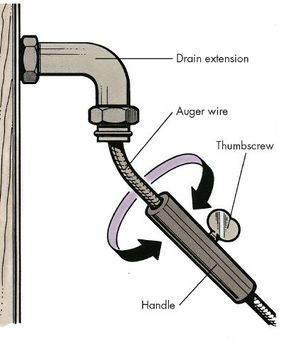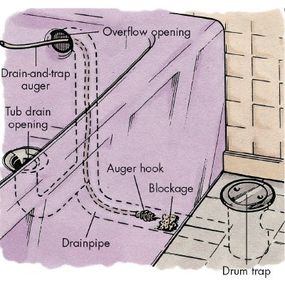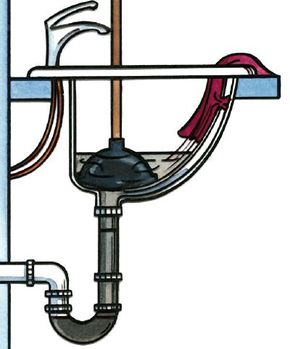How To Clear a Clogged Drain
Dealing with a clogged drain is just no fun. Fortunately, there are steps you can take before calling a plumber to try to clear that clog.
Step 1: Cover overflow opening in basin or tub with wet cloth. Most kitchen sinks don't have an overflow vent, but if you're working on one of two side-by-side basins, plug the other basin's drain opening with wet cloths. In homes that have two bathrooms back to back in adjacent rooms, both may be connected to the same drain. In such cases you must block the other basin at both its drain and overflow vent. Shower facilities seldom have overflow vents; bathtubs do. Cover all of them with wet cloths for plunger to work properly.
Advertisement
Step 2: Fill clogged basin with enough water to cover head of plunger. Coat lip of plunger with petroleum jelly (this helps create better seal). Slide plunger's cup over drain opening, then rapidly pump plunger up and down. You should feel water move in and out of drain. It is this back-and-forth water pressure that can eventually build up enough force to dislodge whatever is blocking drain. After about a dozen firm strikes, jerk plunger up quickly. Water should rush out. If it doesn't, try same procedure two or three more times before attempting another method.

Step 3: If plunger doesn't remove clog, consider using chemical drain opener. For drain that's completely blocked, however, it's best not to use chemicals, as they contain caustic agents that can actually harm some fixtures. Instead, use drain-and-trap auger. To use it, remove popup stopper or strainer from clogged drain and insert auger wire into opening. As you feed flexible wire in, crank handle of device, loosening and then tightening thumbscrew on handle as you advance wire. If wire encounters something, move it back and forth while you turn auger handle. Then continue to turn handle while slowly withdrawing auger.

Step 4: If auger doesn't clear drain, remove clean-out plug from under sink, catching water from trap in bucket. You can use wire coat hanger with hook shape in one end to try to reach clog. If this fails, insert wire of drain-and-trap auger through clean out. Work wire toward basin and drainpipe to remove blockage.
Step 5: If trap does not have clean out, remove trap. (The section How to Replace a Drain Trap provides complete instructions on how to remove and replace a drain trap.) With trap removed, clean it out with wire coat hanger and then with stiff brush and hot soapy water; replace trap. If clog wasn't in trap, insert drain-and-trap auger into drain extension that goes into wall and continue working auger down into drainpipe itself. You should be able to reach blockage, unless it's in section of main drain.
Step 6: If bathtub drain is clogged and plunger doesn't clear it, use drain-and-trap auger first through tub drain opening. If this doesn't work, remove overflow plate and insert auger directly into overflow pipe and down into drainpipe.
Unclogging floor drains and main drainpipes is another job altogether. Find suggestions for tackling these plumbing issues in the next section.
